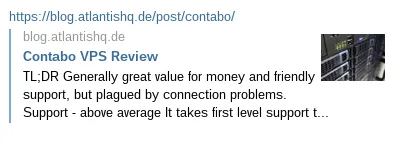Advanced Website Previews
This article describes how to use the Open Graph Protocol and structured data (JSON-LD) to allow messengers, other websites and search-engines to preview elements of your website.
The Open Graph Protocol (OGP)
OGP is used for most small previews in many instant messengers like Signal or Whatsapp, but also on Facebook and Twitter. It’s relatively easy to use and the official documentation actually tells you everything you need to know, but there are some potential pitfalls. Every page on your website must have a correct segment in it’s header. Here is the minimalist’s code for a basic web page:
<html lang="en-us" prefix="og: http://ogp.me/ns#">
<head>
<meta property="og:type" content="website" />
<meta property="og:title" content="Title" />
<meta property="og:description" content="A description" />
<meta property="og:url" content="url_of_current_page" />
<meta property="og:image" content="http://example.de/preview_picture">
</head>
- The prefix in the
<html ..>definition is a RDFa extension, annotating the use of additional semantic vocabularies. Most applications will preview your web pages fine without this information. In my tests, only Telegram seems to actually require it. - The usage of both
og:titleandog:description seemsto be application dependent, some applications will prefer the normal meta-fields “title” or “description” if they exist. Most unfortunately, some will also show an empty description once you added a singleog:tag but noog:description- even if<meta name=description ...>exists. Therefore I would suggest always using the same content in both<meta type=description ..>and the OGP-tag. - Some applications require
og:urlto be set and will not display an image or expand the link if it isn’t. - Concerning
og:image: While most applications will accept both a relative link (ifog:urlwas provided) and an absolute link (including protocol and domain), using a fully qualified absolute link, seems to be the universally accepted format. You may define multiple pictures and resolutions here, but I found that most applications re-render the picture anyway so you will be fine with just one moderately sized picture (~1000-1600px). The extension of the picture doesn’t matter and you don’t have to give an image type, as long as your server sends the correct MIME-type. Some formats won’t work with some applications, most notably WebP and SVG are not widely supported. - Note that some applications and websites may impose additional restrictions or requirements, for example LinkedIn requires pictures to be at least 1200x627px. An instant messenger like Signal will display the above code structure like this:

Instead of posting your links into the application or website of your choice, you may also use opengraphcheck.com to check your OGP-tags.
Structured Data
Structured data in the form of JSON-LD is also used by some applications and websites to generate extended previews of web pages, most notably by Google for it’s Rich Cards.
Every page need’s it’s own structured data section in the HTML header, in the form of a <script type=application/json+ld> tag. There are different types of so called “entities” which represent different constructs of structured data and require different information. There are many well known types, but applications can also define/expect their own types. You can find a list of interesting entity-types in the Google documentation or schema.org.
In other words, write something like this into your <header>:
<script type="application/ld+json">
{
"@context": "http://www.schema.org",
"@type": "Person",
"name": "Your Name",
"url": "https://example.com",
"sameAs": [
"https://github.com/FAUSheppy_",
"https://twitter.com/its_a_sheppy",
"https://blog.atlantishq.de/"
]
}
</script>
The above specifically is the “social” Rich Card. You can have multiple entities after another i.e. like this:
<script type="application/ld+json">
{
"@context": "http://www.schema.org",
"@type": "Person",
...
}
</script>
<script type="application/ld+json">
{
"@context": "http://www.schema.org",
"@type": "CreativeWork",
"author: "Your Name",
"headline": "A title or headline",
"description": "A description",
"thumbnailUrl": "url_to_image",
"image": "url_to_image"
}
</script>
This “Creative Work”-entity is documented on schema.org. The parameters used in the example are the ones most often required in my experience, but, like with the OGP, applications and websites will treat these information very differently — i.e. yet again failing to default to meta-fields or straight out ignoring either thumbnailUrl or image and using one of them regardless of the size of the respectively linked image. As unfortunate as it is, I found that using the same image resolution for thumbnailUrl and image produces way more consistent results, than using a lower resolution image for thumnailUrl.
A testing tool for structured data can be found here.
by Yannik Schmidt
Tags: Structured Data, Open Graph Protocol, HTML/CSS, Web-Development, JavaScript, SEO